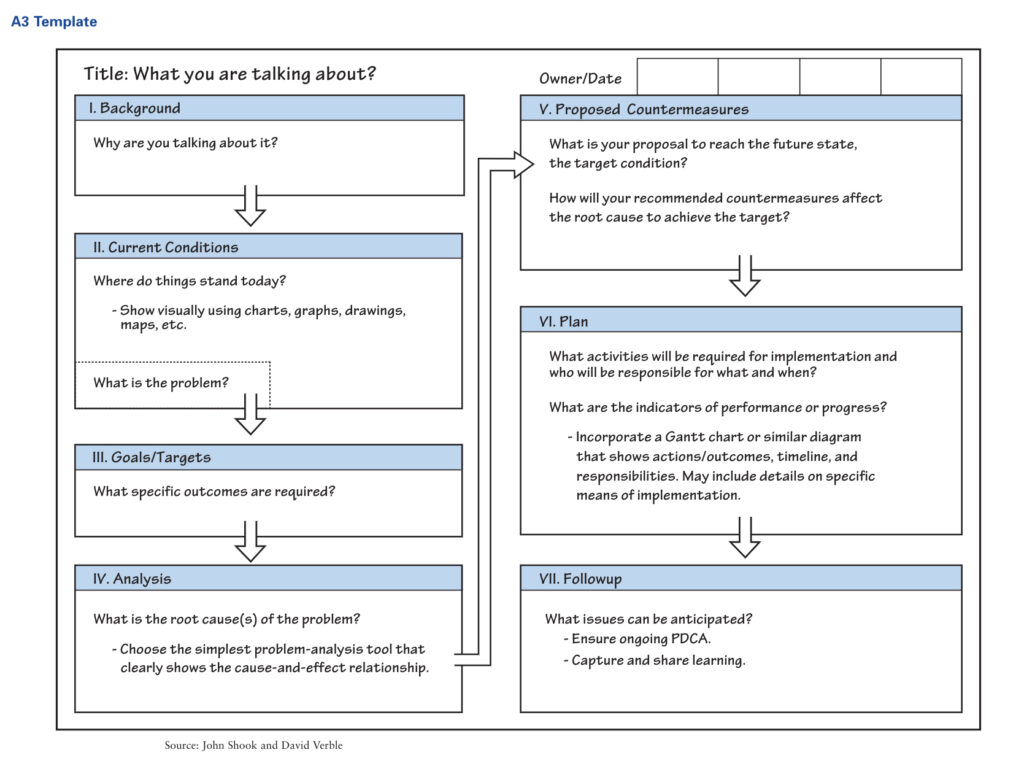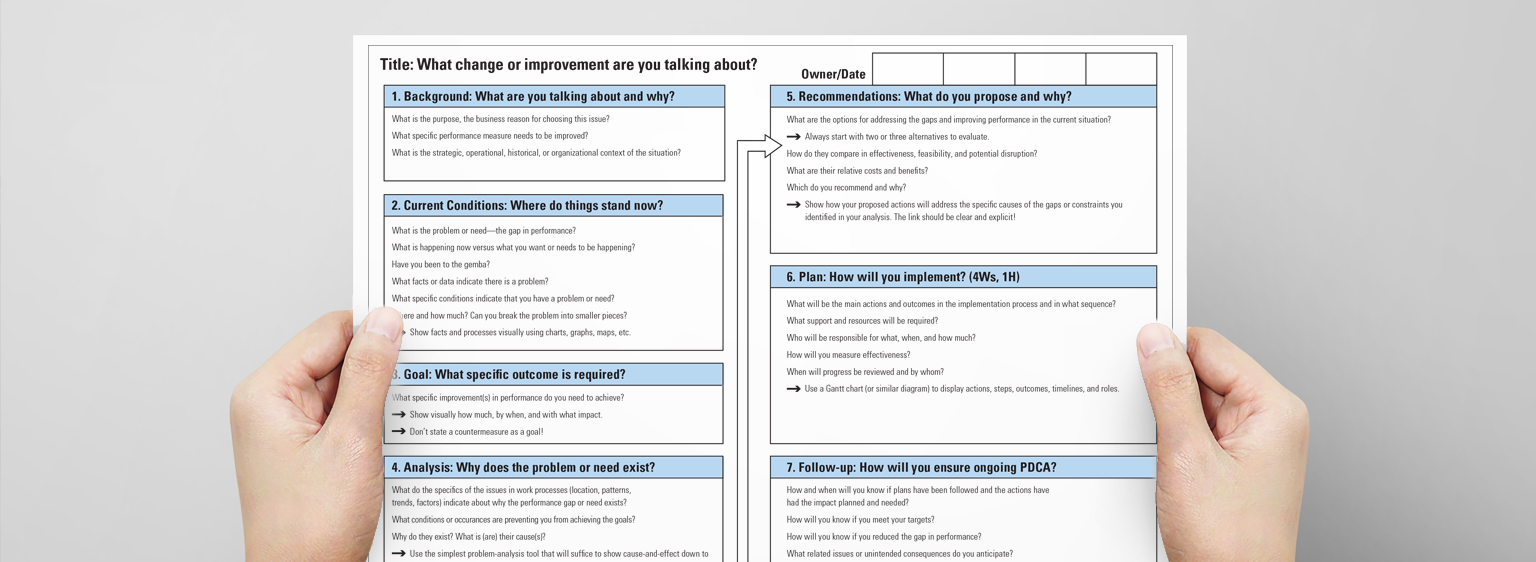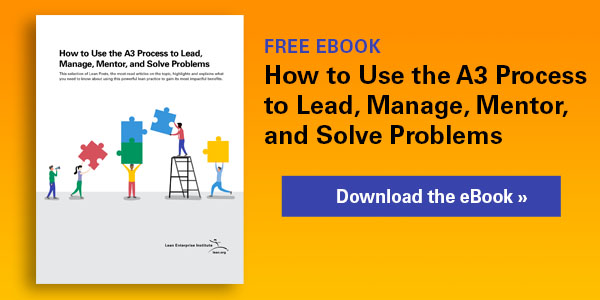If you’re sometimes confused by references to “the A3,” you’re not alone. The term “A3” is used as shorthand to refer to various lean practices. Because understanding this fundamental element of lean management is crucial to a successful lean transformation, here’s a guide describing the multiple contexts in which lean practitioners use the term “A3.”

- A standard paper size: At its most fundamental, “A3” is the international term for a sheet of paper 297 millimeters wide and 420 millimeters long. The closest U.S. paper size is the 11-by-17-inch tabloid sheet.
- A template: Many companies and individuals use an A3-sized document pre-printed with the steps needed to conduct lean problem-solving or improvement efforts, with generous white space for “A3 owners” to record their progress. While they refer to this document as a template, an “A3” is not a template.
- A storyboard: As users record their problem-solving or improvement project’s progress, the A3 becomes a storyboard used to facilitate communication, collaboration, and coordination with other stakeholders affected by the goal the A3 owner is working toward (e.g., solving a problem or improving a process). By having all the facts about the effort in one place, logically presented and summarized, the A3 owner is better able to gain buy-in from other stakeholders for recommended process changes.
- A report: Once the A3 problem-solving effort concludes, the A3 storyboard serves as a report of the problem-solving or improvement initiative, including the facts and data gathered, hypotheses considered, countermeasures tried, experiment results, corrective actions taken, and the overall thinking of the A3 owner and stakeholders. At Toyota and elsewhere, A3 reports have evolved into a standard method for summarizing problem-solving exercises, status reports, and planning exercises like value-stream mapping.
- A problem-solving methodology (or process): Most lean practitioners know “the A3” as a problem-solving process guided by specific steps or questions. The left side of the A3 focuses on various elements of the problem or current condition, and the right on the countermeasures considered, tested, and chosen that resolves the issue or creates a higher standard.
- A management discipline (or process): At a higher level, lean leaders, managers, and supervisors use “the A3” as a means by which they oversee and guide subordinates while simultaneously helping them develop their lean thinking and practice — particularly lean leadership and problem-solving — capabilities. With A3 management, leaders challenge their direct reports to solve a problem. Then, with the A3 report guiding the dialogue and analysis, leaders coach them through the problem-solving process. Importantly, leaders coach by asking questions versus providing answers, ensuring responsibility remains with the subordinate to solve the problem by pursuing facts and building consensus. Through this interaction, subordinates address the issue, allowing them to make progress toward the objective and, in so doing, learn the lean approach to leadership and management and gain problem-solving capability.
- A3 thinking (or analysis): Most A3 coaches and advanced lean practitioners refer to “the A3” as a thinking process. In this case, the term refers to a systematic approach to resolving problems or improving work processes. Someone can follow this systematic approach, regardless of whether they are guided by or record their findings on an A3 document.
- An alignment tool: Advanced lean organizations that have incorporated lean thinking and practices throughout their operations use “A3s” as part of their strategy deployment and execution efforts. In this case, the A3 process ensures a standard approach to managing and coaching people, all directed toward solving problems that help achieve corporate objectives.
Overall, the A3, however deployed, exemplifies the learn-by-doing philosophy embedded in lean thinking and practice.
Managing to Learn with the A3 Process
Learn how to solve problems and develop problem solvers.





In theory this is a great form of developing and implementing improvements which are sustained. But…. How many CEOs (because this is where it should start), managers and supervisors are trained and are world-class coaches? Is it 99.9994% or, as I suspect 0.0006%?
Now look at the gold standard of management education, the MBA. How many of these very lucrative degrees have, as their foundation, a good coaching course so that the newly minted MBA emerges as a great coach with good practical experience? Does the MBA at Utah State (the home of the Shingo Institute) including coaching? Nada, I suspect.
Sadly, MBAs (poor babies) are great at analysis and can spot a problem in a speadsheet from outer space, but ask them how they would grow the capabilities of their people and you might as well be speaking academic Zogg. The pall of F W Taylor still hangs over the thinking of that vast majority of those who are responsible for the work and well-being of others: they think, their teams only do.
Now add Milton Friedman’s edict of “maximising shareholder value” to the mix and training and education is usually the first budget to get cut when rpofits look a tad shaky. Just look at the state of Detroit today which was riddled with Friedmanites.
Another thing that annoys me is that, by now, the basics of Lean should be taught to young people aged 16-18: it is not rocket science. It should not be the monopoly of consultants. Now imagine if these young people were taught how to use and A3 to plan a project, AND how to coach someone who was doing so. Wouldn’t this give them better knowledge of which organisations to choose when entering the world of work?
The Lean education process needs a radical overhaul.
Hi Patricia! It is Great. When dry and empty A3 form is filled by real data and completed, it appears as a success story. As John says it tells a story that can unify an Organization. Best regards!
Totally agree. When people put the whole story on one sheet, it helps everyone see the problem, as Shook said, through the “same lens.” The method reminds me of 5S, but for information instead of a workplace— to get to story to fit on one sheet, everything unnecessary must be jettisoned. Then, the real story almost tells itself. I’ve watched the A3 method transform project reviews and just about every other management review. Less time going over a 15-slide PPT means more time to dive into meaty issues. Thanks Patricia!
Thanks Patricia, Really enjoy this breakdown. My favorite thing about an A3 is the coaching and organizational elements. We balance toyota kata story boards with A3’s through are strategic deployment system. Really believe that many would embrace A3’s if they viewed them as a shared framing for coaching.